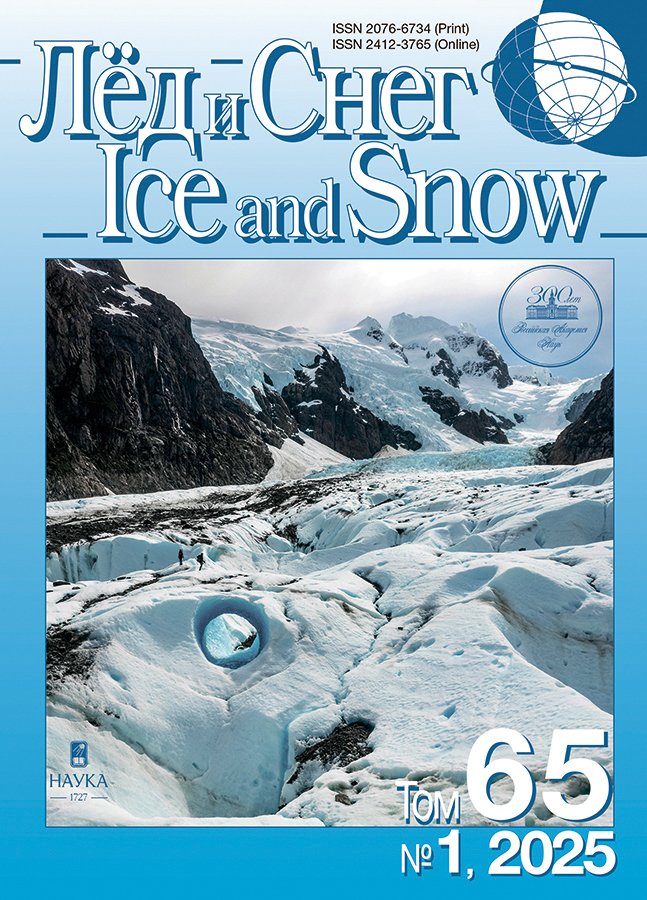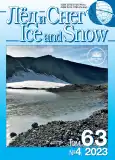Analysis of the Main Factors Controlling the Formation of Subaerial Taliks, Using a One-Dimensional Mathematical Model. A Case Study for the Shestakovka River Basin (Central Yakutia)
- Authors: Popov S.V.1,2, Boronina A.S.2,3, Lebedeva L.S.2
-
Affiliations:
- Saint-Petersburg State University, Saint Petersburg
- Melnikov Permafrost Institute
- State Hydrological Institute
- Issue: Vol 63, No 4 (2023)
- Pages: 597-611
- Section: Ground ices and icings
- URL: https://journals.rcsi.science/2076-6734/article/view/162334
- DOI: https://doi.org/10.31857/S2076673423040130
- EDN: https://elibrary.ru/FQDPWS
- ID: 162334
Cite item
Full Text
Abstract
Received March 9, 2023; revised September 7, 2023; accepted October 2, 2023
This study presents a mathematical model of heat transfer in a subaerial talik. The model is based on the concepts presented in classical works on permafrost, as well as on the results of geological and geophysical research carried out in the Shestakovka River basin (Central Yakutia). This model is based on the solution of the classical Stefan problem on the moving of the phase transition boundaries for a multilayer and multiphase medium. The solution was calculated on a unstructured mesh. When the phase boundaries move, thawed or frozen layers of soil are formed or wedged out. The layers include: snow cover, seasonally thawed soil, seasonally frozen and frozen sand deposits, as well as soil-vegetative layer. Published empirical relationships were used to calculate thermophysical coefficients, which are presented in this article. Simple variants of the model were considered to clarify the contribution of various factors to the process of formation and evolution of taliks. It has been established that the presence of snow cover and soil-vegetative layer have the most significant effect on the formation of taliks. Calculations show that taliks are formed in the first years of the modeled period, in the presence of snow and the absence of soil-vegetative layer. The soil-vegetative layer, depending on its composition and moisture content (ice content), can prevent the formation and development of taliks. The authors do not consider cases where shrubs contribute to snow accumulation. The humidity and iciness of the layer of sand sediments located in Central Yakutia have practically no effect on this process.
About the authors
S. V. Popov
Saint-Petersburg State University, Saint Petersburg; Melnikov Permafrost Institute
Author for correspondence.
Email: spopov@yandex.ru
Russia, Russia; Russia, Yakutsk
A. S. Boronina
Melnikov Permafrost Institute; State Hydrological Institute
Email: spopov@yandex.ru
Russia, Yakutsk; Russia, Saint Petersburg
L. S. Lebedeva
Melnikov Permafrost Institute
Email: spopov@yandex.ru
Russia, Yakutsk
References
- Boitsov A.V. The Conditions of Formation and the Regime of Ground Waters of Supra-permafrost and Intra-permafrost Runoff in Central Yakutia. PhD. Yakutsk: Melnikov Permafrost Institute, SB RAS, 2002: 176 p [In Russian].
- Boitsov A.V. Conditions of formation and the regime of slope taliks in Central Yakutia. Kriogidrogeologicheskie issledovaniya. Cryohydrogeological studies. Yakutsk: Melnikov Permafrost Institute SB RAS, 1985: 44–55 [In Russian].
- Varlamov S.P., Zhirkov A.F., Nakhodkin D.A. Ground temperature regime after surface disturbance under current climatic conditions in Central Yakutia. Prirodnye resursy Arktiki i Subarktiki. Arctic and Subarctic Natural Resources. 2017б, 88 (4): 65–71 [In Russian].
- Varlamov S.P., Skachkov Yu.B., Skryabin P.N. Interannual variability of soil temperature parameters at the Chabydinskiy station (Central Yakutia). Voprosy razvitiya i osvoeniya merzlyh tolshch. Yakutsk: Issues of development and development of frozen strata. Yakutsk: Melnikov Permafrost Institute SB RAS 1900: 68–75 [In Russian].
- Varlamov S.P., Skachkov Yu.B., Skryabin P.N. Results of 35-year monitoring studies of the permafrost zone at the Chabyda station (Central Yakutia). Prirodnye resursy Arktiki i Subarktiki. Arctic and Subarctic Natural Resources. 2017а, 86 (2): 34–40 [In Russian].
- Varlamov S.P., Skryabin P.N. Dynamics of the soil thermal state in permafrost landscapes in Central Yakutia. Izvestiya Samarskogo nauchnogo tsentra Rossiyskoy Akademii nauk. Izvestia RAS SamSC. 2012, 14 (1 (8): 2040–2044 [In Russian].
- Gavriliev R.I. Generalization of the relationship of thermal and physical properties of various types of soils and peatlands. Merzlye grunty pri inzhenernyh vozdeystviyah. Frozen soils under engineering impacts. Novosibirsk: Science. 1984: 14–28 [In Russian].
- Gavriliev R.I. Teplofizicheskie svoystva gornyh porod i napochvennyh pokrovov kriolitozony. Thermophysical properties of rocks and ground covers in the permafrost zone. Novosibirsk: Siberian Branch of the Russian Academy of Sciences, 1998: 279 p. [In Russian].
- Gagarin L.A., Bazhin K.I., Olenchenko V.V., Ogonerov V.V., Qingbai Wu. Revealing potential thermos-suffosional soil loosening sites along A-360 Lena federal highway, Central Yakutia. Kriosfera Zemli. Earth’s Cryosphere. 2019, XXIII (3): 61–68 [In Russian].
- Gorelik J.B., Pazderin D.S. Correctness of formulation and solution of thermotechnical problems in forecasting temperature field dynamics in the foundations of constructions on permafrost. Kriosfera Zemli. Earth’s Cryosphere. 2017, XXI (3): 49–59 [In Russian].
- Lebedeva L.S., Bazhin K.I., Khristoforov I.I., Abramov A.A., Pavlova N.A., Efremov V.S., Ogonerov V.V., Tarbeeva A.M., Fedorov M.P., Nesterova N.V., Makarieva O.M. Suprapermafrost subaerial taliks, Central Yakutia, Shestakovka river basin. Kriosfera Zemli. Earth’s Cryosphere. 2019, XXIII (1): 40–50 [In Russian]. https://doi.org/10.21782/KZ1560-7496-2019-1(40-50)
- Osokin N.I., Samoilov R.S., Sosnovskii A.V., Sokratov S.A., Zhidkov V.A. On estimation the influence of snow cover characteristics variability on soils freezing. Kriosfera Zemli. Earth’s Cryosphere. 1999, III (1): 3–10 [In Russian].
- Pavlov A.V., Teplofizika landshaftov. Thermal physics of landscapes. Novosibirsk: Nauka, 1979: 284 p. [In Russian].
- Pavlova N.A., Shepelev V.V., Galanin A.A., Efremov V.S. Groundwater hydrochemistry of suprapermafrost–intrapermafrost flow in their discharge areas in Central Yakutia. Vodnye resursy. Water Resources. 2020, 47 (4): 391–401.
- Permyakov P.P, Afanasyeva T.A, Varlamov S.P, Skryabin P.N. Determining boundary conditions in modeling the thermal regime of frozen soils. Vestnik Severo-Vostochnogo nauchnogo tsentra DVO RAN. Bulletin of the North-East Scientific Center, Russia Academy of Sciences Far East Branch. 2018, 1: 56–62 [In Russian].
- Permyakov P., Afanasyeva T., Varlamov S., Skryabin P. On the efficiency of boundary conditions restoration when modeling of the thermal regime of frozen soils. Vestnik zabaykal’skogo gosudarstvennogo universiteta. Transbaikal State University Journ. 2017, 23 (5): 27–35 [In Russian].
- Popov S.V., Boronina A.S., Lebedeva L.S. Formulation of the problem and choice of solution methods for numerical simulation of thermophysical processes in water-bearing subaerial taliks. Materialy IV Vserossijskoj nauchnoj konferencii s mezhdunarodnym uchastiem “Vodnye i ekologicheskie problemy Sibiri i Central’noj Azii”. Proc. of the IV All-Russian scientific conf. with international participation “Water and environmental problems of Siberia and Central Asia”. 2022, 1: 214–222 [In Russian].
- Samarskij A.A., Vabishchevich P.N. Chislennye metody resheniya zadach konvekcii-diffuzii. Numerical methods for solving convection-diffusion problems. Moscow: URSS, 2003: 246 p. [In Russian].
- Popov S.V. Solution of the one-dimensional Stefan problem with two transitions for modelling of the water freezing in a glacial crevasse. Led i Sneg. Ice and Snow. 2023, 63 (1): 130–140 [In Russian]. https://doi.org/10.31857/S2076673423010131
- Sosnovsky A.V. Мathematical modelling of the influence of snow cover thickness on degradation of permafrost at climate warming. Kriosfera Zemli. Earth’s Cryosphere. 2006, X (3): 83–88 [In Russian].
- Sosnovsky A.V. Calculation of the optimal thickness of the water-ice mixture layer during ice freezing over large areas. Materialy Glyatsiologicheskikh Issledovaniy. Data of Glaciological Studies. 1984, 50: 223–231 [In Russian].
- Sosnovsky A.V., Osokin N.I. Impact of moss and snow cover on the sustainability of permafrost in West Spitsbergen due to climate change. Vestnik Kol’skogo nauchnogo tsentra RAN. Herald of the Kola Science Centre of RAS. 2018, 3: 178–184 [In Russian].
- Tishkov A.A., Osokin N.I., Sosnovsky A.V. The Impact of Moss Synusia on the Active Layer of Arctic Soil and Subsoil. Izvestiya Rossijskoj akademii nauk. Seriya geograficheskaya. News of the Russian Academy of Sciences. Geographical series. 2013, 3: 39–46 [In Russian].
- Ugarov I.S., Efremov P.V. Active-layer soil moisture in the Lena River basin. Uspekhi sovremennogo estestvoznaniya. Advances in current natural sciences. 2022, 10: 88–92 [In Russian].
- Feldman G.M. Metody rascheta temperaturnogo rezhima merzlyh gruntov. Methods for calculating the temperature regime of frozen soils. Moscow: Nauka, 1973: 254 p. [In Russian].
- Feldman G.M. Peredvizhenie vlagi v talyh i promerzayushchih gruntah. Movement of moisture in thawed and freezing soils. Novosibirsk: Nauka, 1988: 258 p. [In Russian].
- Shender N.I., Boytsov A.V., Tetelbaum A.S. Formation of taliks and high-temperature frozen rocks in the conditions of Central Yakutia. Materialy Pervoj Konferencii geokriologov Rossii. Proc. of the First Conf. of Geocryologists of Russia. Moscow: MSU, 1996: 529–537 [In Russian].
- Jafarov E.E., Romanovsky V.E., Genet H., McGuire A.D., Marchenko S.S. The effects of fire on the thermal stability of permafrost in lowland and upland black spruce forests of interior Alaska in a changing climate. Environ Res Lett. 2013, 8 (3): 035030. https://doi.org/10.1088/1748-9326/8/3/035030
- Lebedeva L., Pavlova N., Khristoforov I. Geology, structure, ground temperature and groundwater level in aquifer taliks in the Shestakovka River Basin, Eastern Siberia. Land. 2023, 12 (1):16. https://doi.org/10.3390/land12010016
- Rowland J.C., Travis B.J., Wilson C.J. The role of advective heat transport in talik development beneath lakes and ponds in discontinuous permafrost. Geophysical Research Letters. 2011, 38 (17): L17504. https://doi.org/10.1029/2011gl048497
- Zhang Y., Wolfe S.A., Morse P.D., Olthof I., Fraser R.H. Spatiotemporal impacts of wildfire and climate warming on permafrost across a subarctic region, Canada. Journ. Geophys. Res. Earth Surf. 2015, 120 (11): 2338–2356. https://doi.org/10.1002/2015JF003679
Supplementary files
















